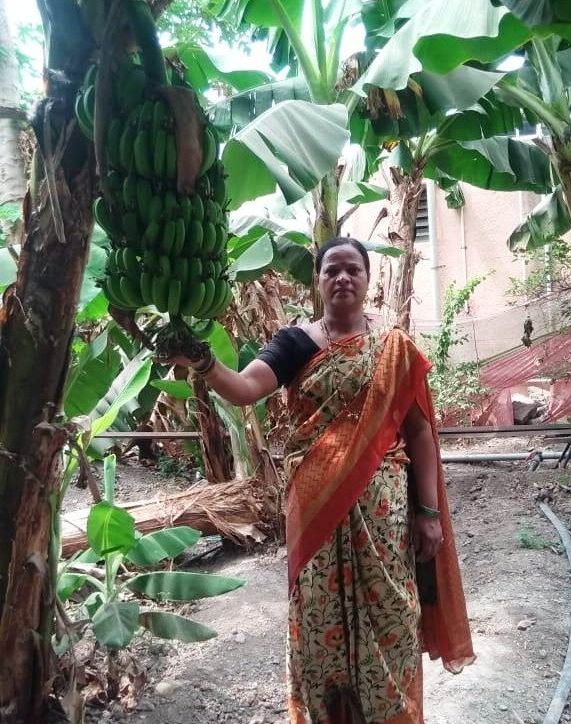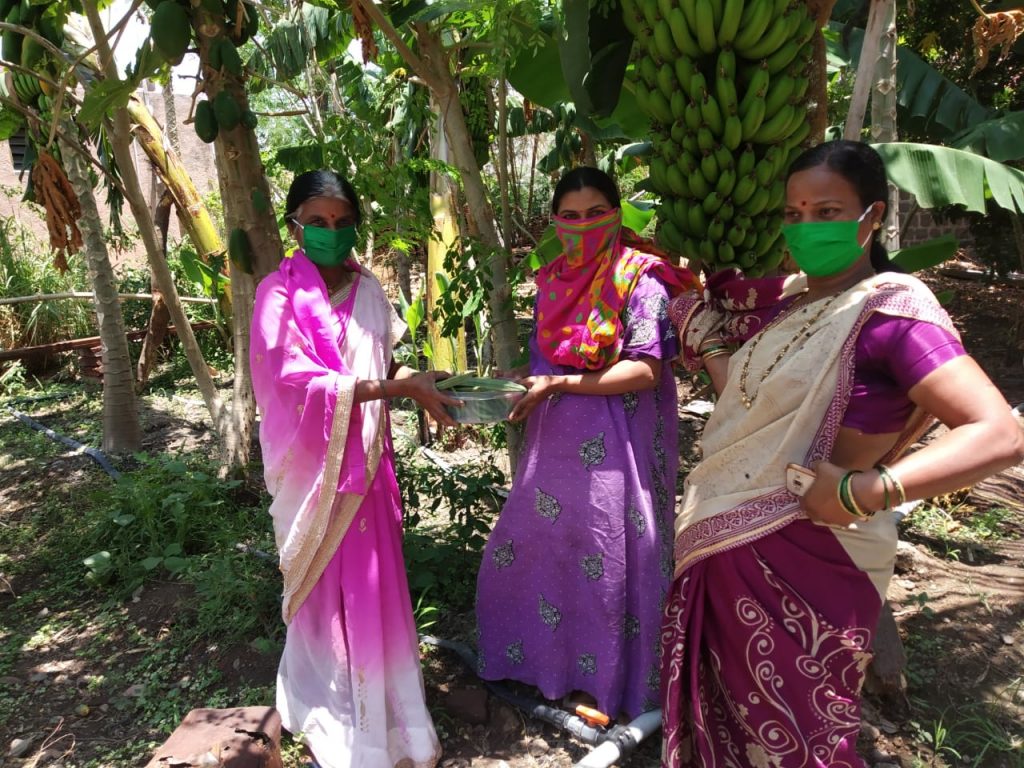

Are we compromising nourishment in our families by simply satiating hunger? The answer is yes. The nutrition and health status of millions of families, especially in the rural areas, are at stake. Insufficient food and inadequate nutrition are a reality. India is one of the worst-performing countries on child health indicators. The Global Hunger Index 2020, which is calculated based on the total undernourishment of the population, places India in the 94th spot among 107 countries. The National Family Health Survey indicates that the problem of child and maternal malnutrition is responsible for 15 per cent of India’s total disease burden.
One of the tangible solutions for malnourishment is the promotion of sustainable farming techniques which can generate varied crops of high nutritional value. They must also include options for income generation for the household in their limited cultivable land. With these objectives, multilayer farming is a gift for all land category farmers in India. Farmers can maximise land use and grow different crops, vegetables, fruits, flowers, and medicinal plants in one place simultaneously.
Multilayer farming, also known as multi-tier farming, is an advanced intercropping technique increasingly promoted by the Government and non-profit agencies like us, WOTR, in project areas. It includes the cultivation of vegetables, fruits, and flowers. Crops of different heights, root and shoot patterns, photosynthetic rates and maturation time are selected in this farming technique to mix and match their adaptability and feasibility in the small plot available to the farmer.


 Multilayer farming, also known as multi-tier farming, is an advanced intercropping technique increasingly promoted by the Government and non-profit agencies like us, WOTR, in project areas. It is an easily adaptive, cost-effective and participatory farm technique for sustainable, secure and Atmanirbhar (self-reliant) Bharat. It is mainly done with high-nutritional crop
Multilayer farming, also known as multi-tier farming, is an advanced intercropping technique increasingly promoted by the Government and non-profit agencies like us, WOTR, in project areas. It is an easily adaptive, cost-effective and participatory farm technique for sustainable, secure and Atmanirbhar (self-reliant) Bharat. It is mainly done with high-nutritional crop  value for domestic consumption. It includes the cultivation of vegetables, fruits, and flowers. Crops of different heights, root and shoot patterns, photosynthetic rates and maturation time are selected in this farming technique to mix and match their adaptability and feasibility in the small plot available to the farmer.
value for domestic consumption. It includes the cultivation of vegetables, fruits, and flowers. Crops of different heights, root and shoot patterns, photosynthetic rates and maturation time are selected in this farming technique to mix and match their adaptability and feasibility in the small plot available to the farmer.
 Indian agriculture is traditionally characterised by low and uncertain returns. It is a vicious circle. Low savings results in low investment, and it gives low return and hence, low savings. With multilayer farming, low investment results in high returns. Therefore, high savings result in the prosperity of nutritional and financial security of the rural household.
Indian agriculture is traditionally characterised by low and uncertain returns. It is a vicious circle. Low savings results in low investment, and it gives low return and hence, low savings. With multilayer farming, low investment results in high returns. Therefore, high savings result in the prosperity of nutritional and financial security of the rural household.
Scientifically, multilayer farming is also low-risk farming. Single crops can be damaged by drought, floods, hailstorms, hurricanes and epidemics. However, multilayer farming provides insurance against crop failure, reduces pest and disease incidence and provides additional yield advantage from the intercrops as bonus yield. Legumes used as intercrops help fix atmospheric nitrogen and thus improve soil properties and fertility conditions. This type of farming employs efficient utilisation of resources like air, water, light, space, and nutrients resulting in higher returns and better nutritional value.
Our experience of working in around seven States of India for the last three decades and consecutive data collected from the project areas have scientifically established that multilayer farming helps promote sustainable agriculture. It minimises crop-weed competition and soil erosion and maintains the texture and fertility of the land.
 Some of the essential steps of successful multilayer farming begin with the proper selection and preparation of the field. Seeds/plant selection and their treatment with ecologically-friendly methods is another area of expertise that we, along with our expert team on multilayer farming, have attained
Some of the essential steps of successful multilayer farming begin with the proper selection and preparation of the field. Seeds/plant selection and their treatment with ecologically-friendly methods is another area of expertise that we, along with our expert team on multilayer farming, have attained  with time.
with time.
Irrigation has to be a controlled one, neither much nor less water is required. Our experts suggest the rain irrigation method as one of the best-suited ones.
Organic manures and other organic formulations are most  suited, and we undertake special training for farmers to make them. Intercultural operations like weeding, mulching, earthing up, harvesting and post-harvesting techniques are other areas where farmers require expert hand-holding.
suited, and we undertake special training for farmers to make them. Intercultural operations like weeding, mulching, earthing up, harvesting and post-harvesting techniques are other areas where farmers require expert hand-holding.

Rohini from Wadgaon Tanpura village in Ahmednagar District of Maharashtra is a shining example of the success of multilayer farming and its impact on the prosperity of families. Our project in this village aimed to promote multilayer farming as an activity for improving household food and nutrition security to make people more resilient during any form of crisis, such as drought or even a pandemic.
Growing different plants on her small plot proved to be an important step to reduce market dependability and achieve food sovereignty for Rohini and many other families in her village. Adopting sustainable farming methods has helped them maintain a balanced diet as well. Rohini and other villagers have scores of testimonies to share how domestic farming of safe and nutritious vegetables and fruits helped their families during the trying phase of COVID-19.
Basic amenities were scarce in Rohini’s village, and expert help in farming was beyond anyone’s imagination until our expert team arrived for a study a few years ago. Rohini and her husband Ashok decided to take up the lesser-known type of farming in the region as part of the first batch of farmers.
Rohini Bhoge tells us her story of how multilayer farming has benefitted her and her fellow villagers. “With support, I started multilayer farming on an additional 10R (guntha) plot. I grew vegetable crops like Spinach, Fenugreek, Dill (Shepu) and Coriander. I added climbers like Ridge Gourd, Bottle Gourd, and Bitter Gourd. I was also guided by the WOTR expert team to add tubers and roots like Beet, Garlic, Onion, Radish, and Carrot. It did not stop there. The team helped me to add Drumstick, Dolichos Beans, and Cowpea. I then added fruit crops too like Papaya, Banana, Sapota, Mango, Jamun, Guava, Lemon and spices like Curry Leaves, allspices, Coriander, etc.,” she said.
Growing different plants on her small plot proved to be an important step to reduce market dependability and achieve food sovereignty for Rohini and many other families in her village. Adoptiong sustainable farming methods has helped them maintain a balanced diet as well. Rohini and other villagers have scores of testimonies to share on how domestic farming of safe and nutritious vegetables and fruits helped their families during the trying phase of COVID-19.
The villagers of Wadgaon Tanpura received multiple benefits from this new farming method. Optimal utilisation of soil and water, ecological balance in the environment, prevention of water evaporation from the soil, saving around 70 per cent of groundwater, increased income per unit area, and minimum risk of crop failure are few of the main benefits.



We want to mention here that the awareness-building period of multilayer farming at Rohini’s village was not an easy task for us. The farming community was apprehensive of the new technique. But with small model plots developed as demonstrative ones, they gained confidence and are now reaping the benefits of this type of farming.
As part of our approach, our trained Mahila Pravartaks (health promoters) spread awareness among villagers on the importance of nutrition and diet. We have been promoting multilayer farming since 2018, and to date, 1124 plots across 150 villages in Maharashtra have been following this unique farming for food and nutrition security.

Many success stories have emerged from the rural hinterlands of India.
Sangita Tikonkar from Satara district in Maharashtra says that within 30 days, they witnessed the leafy vegetables growing. Earlier, they used to have kitchen gardens which would run until November or December. After that, they would have to go and buy vegetables from the market. Sangita says that taking up multilayer farming has made her life much easier.
Nandini Bhosale, another woman farmer, says she could never have imagined that 25 crops could be grown in this small plot of land and with little water. Since the area is very small, it is easy for her to manage things organically. Her children are also eagerly helping her farm. Ghanshyam, who has lived in an area affected by drought for the last three years, says that the irrigation technology in multilayer farming is different and very little water is required. The time and effort for irrigation are relatively less compared to flood irrigation. He further says that pests on their crops have reduced, and they make a weekly amount of Rs 500-600 by selling the excess produce.
As part of our approach, our trained Mahila Pravartaks (health promoters) spread awareness among villagers on the importance of nutrition and diet.
We have been promoting multilayer farming since 2018, and to date, 1124 plots across 150 villages in Maharashtra have been following this unique farming for food and nutrition security.



When the whole nation was under lockdown, we were involved in creating awareness about hygiene and sanitation and helping the authorities implement activities required to arrest the spread of the Coronavirus. There were a few project activities which we had already implemented, which proved to be very beneficial to the community during those testing times; multilayer farming stood out among them. It helped fight the crisis and assured our rural households of a continuously improved food and nutrition security by making them Atmanirbhar – self-reliant for their balanced dietary needs.
Multilayer farming undoubtedly makes people more resilient during any crisis such as drought or even a pandemic.

